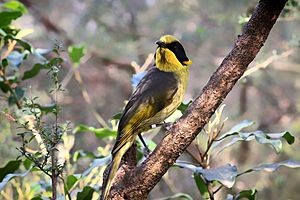Helmeted honeyeater facts for kids
Quick facts for kids Helmeted honeyeater |
|
|---|---|
 |
|
| Conservation status | |
| Scientific classification | |
| Kingdom: | |
| Class: | |
| Order: | |
| Family: | |
| Genus: |
Lichenostomus
|
| Binomial name | |
| Lichenostomus melanops |
|
The helmeted honeyeater (Lichenostomus melanops cassidix) is a very special and endangered species of bird. This means there are only a few of them left in the world. You can only find a tiny group of these birds in the Yellingbo Nature Conservation Reserve in Victoria, Australia. In 1971, the helmeted honeyeater became the official bird emblem for the state of Victoria.
A famous bird expert named John Gould first described this bird in 1867. He thought it was a separate species. Now, we know it is one of three types, or subspecies, of the yellow-tufted honeyeater, Lichenostomus melanops. The other two subspecies are not endangered.
Contents
Where This Bird Lives
This unique bird lives in a small area of forest. It's about five kilometers long, along two streams. This special place is the Yellingbo Nature Conservation Reserve. It is about 50 kilometers east of Melbourne.
A special reserve was also set up in the Bunyip State Park. This was for releasing birds that were raised by people. In 2003, there were only 103 helmeted honeyeaters living in the wild. There were also 34 birds being cared for at the Healesville Sanctuary.
During the 2009 Victorian bushfires, the fires came very close to the birds' home. They were only 200 meters away from the bird colony at Bunyip State Park. The birds at Healesville Sanctuary also had to be moved to the Melbourne Zoo for safety. But good news came on April 28, 2009. Thirteen birds that were raised in captivity were set free. Now, there are believed to be about 113 wild birds.
Before the special breeding program started, there were only about 50 to 60 birds left in the wild. These birds have been bred at Healesville and at Sydney's Taronga Park Zoo.
What the Helmeted Honeyeater Looks Like
The helmeted honeyeater is about 20 centimeters (8 inches) long. That's about the length of a ruler. Their feathers can be different shades, from black to olive green. They have a bright yellow patch on their heads, which looks a bit like a helmet!
What They Eat
Helmeted honeyeaters have a special diet. They eat manna, which is a sweet sap that comes from some eucalyptus trees. They also enjoy nectar from the flowers of eucalyptus trees. Besides these sweet treats, they also eat small insects and spiders.
Helping to Save the Helmeted Honeyeater
Many people are working hard to stop this bird from becoming extinct. One important effort is a special breeding program. In this program, birds are raised at Healesville and Taronga Park Zoo.
When the young birds are about 6 to 8 months old, they are released into the wild. The hope is that they will then start to breed and have their own chicks.
People are also planting the right kinds of trees and plants in forest areas. This helps to give the birds more food and safe places to live. This planting is happening on private land and in State parks. They are also planting trees to connect small patches of bushland. This creates "corridors" so the birds can move around safely. This stops them from being stuck in just one small area.
See also
 In Spanish: Mielero de casco para niños
In Spanish: Mielero de casco para niños


